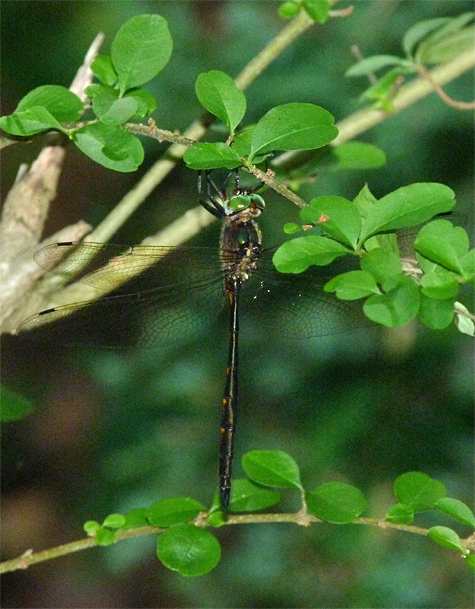
Back in July of 2008 I found the remains of a dragonfly on the path in Catch the Wind. There was enough of the insect to determine that it was a Mocha Emerald, a dragonfly of small, shady forest streams. I added that ode to the list of dragonflies that could potentially be encountered (alive) here at the Museum.
I based the dragonfly’s inclusion to the list on the fact that I found the insect where I did (in Catch the Wind) and assumed that a bird (or larger ode) had captured the dragonfly and dropped the remains where I had found them. There are two small shaded streams running through the property. I assumed that one of those streams was where the dragonfly had originated.
I no longer have to assume whether or not Mocha Emeralds actually do occupy part of the eighty-four or so acres here at the Museum. A few days ago, while photographing Elderberry (photos coming soon) I noticed a large, slender, dark ode flying back and forth in the shady understory of the woods near where I stood. The ode appeared to be searching for a place to perch. It perched, and I took several photos.
Mocha Emeralds are known as emeralds because, as mature adults, they have green eyes. The mocha part of the name comes from, I assume, their dark brown coloration. I think it’s safe to assume that it does not come from the dragonfly’s chocolaty taste, or that the dragonfly was first described in Mocha, Yemen. Wait, wait, did he say Yemen?
The color mocha and the chocolaty coffee mocha have everything to do with Yemen. Mocha, Yemen was and is a sea port which is known for its export of a strong, dark, sweet coffee. This coffee is said to have a chocolaty taste to it. It is brewed with mocha beans. Today, any coffee with chocolate added to it is called mocha.
I don’t drink coffee or eat chocolate, so none of this info was gained through personal experience. But, it seems to me that the dragonfly in the photo above gets its common name from a chocolaty tasting coffee bean grown in Yemen, at least in some indirect way.
Meanwhile, down in the Wetlands, Comet Darner, Common Green Darner, Red Saddlebags, Slaty Skimmer, and Great Blue Skimmer have joined the ranks of the Blue Dashers, Eastern Amberwings, and other dragonflies already patrolling and mating over the brown, mocha-colored water. All but the Green Darner of the five newcomers above were first seen this season during the last few days of May or the first few days of June.
Happy oding.